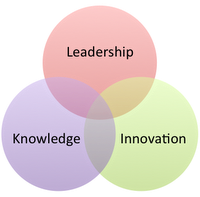by Wayne Kelly, 31/05/2012
Knowledge has always been a critical part of development and economic success; the knowledge-based nature of the current economy magnifies its importance, relying more and more on higher levels of education and technical capacity along with digital technology. The importance of knowledge and its role as a foundation for this new economy is described here.
The critical role of knowledge and digital information is highlighted for me by two recent examples that I have encountered, one through personal experience with rural communities here in Manitoba and one through reading about small farms in developing countries.
Here in Manitoba, there are several rural communities that are booming from immigration, some of these communities such as Winkler, MB are ranked in the top five communities in Canada in regards to immigrants per capita. For all of these communities with a rapidly expanding immigrant population, knowledge of current population figures is critical for effective service delivery and development projects. Although Statistics Canada collected census data just last year, population numbers can already be off by more than 20% in some of these communities. That size of population variance has substantial impacts on funding, planning and success for these communities. Knowing population figures as accurately as possible is an essential part of development within these communities.
Another example of the importance of knowledge in community and rural development is found in exploring how small scale farmers in developing countries are using access to information and knowledge to completely change their livelihoods. Paul Polak includes access to information as a critical success factor for small farmers in his book Out of Poverty. He describes the importance of knowing daily and even hourly market rates for vegetable and cash crop prices as an important tool for farmers to raise themselves out of poverty. Other examples include mfarmers, connecting farmers with mobile phones and the Internet to provide vital weather and market information to farmers in Ethiopia and other countries.
Knowledge and information are critical in rural community development and as these two small examples illustrate, this ingredient spans the public and private sector as well as the developed and the developing world.
The Innovation Ingredient
Innovation is defined as the use of new methods, tools processes or products. Innovation, or ‘new ways of doing things’ is important to rural communities as it can provide the disruptive opportunity needed to solve geographic, demographic or market barriers that face many rural communities. Doing something new or in a different way can turn the existing situation on its head, providing solutions where before there were none and create opportunities out of challenges.
While it’s cliche, Darwin’s quote regarding adaptability definitely outlines a key characteristic of rural community development in this new economy:
“It is not the strongest of the species that survives, nor the most intelligent that survives. It is the one that is the most adaptable to change.”
Recently at an rural entrepreneurship conference in Manitoba, Capturing Opportunities, several of the key note speakers focused on the importance of innovation and doing things differently in rural communities. Dr. Jeff Stamp and John Schneider have both successfully incorporated innovation into development efforts. Dr. Jeff Stamp is an innovation expert who helps entrepreneurs and organizations harness their creative ways. He continually promoted tackling problems with new ideas and solutions, asking core questions such as “why” when deciding on those solutions and the importance of trying and trying again, even when met with failure.
John Schneider is the director of North Dakota’s Agricultural Products Utilization Commission (APUC) whose mandate relies on innovation to: create wealth and jobs through the development of new and expanded uses of North Dakota’s agricultural products through a grant program. This program is based on supporting and encouraging innovative adaptations of local agricultural products and it is heralded as a leader in this field. One of the novel aspects of the APUC program in North Dakota is that it walks the talk as well, using innovative approaches to investment and support to ensure that its clients have the best chance of success. Adapting funding and guidelines for its program to meet the needs of clients rather than forcing clients to adapt to the funding is a key to the program’s success.
Innovation is a critical aspect of rural community development success and it is consistently those communities willing to try new things, to focus on creative solutions for needs rather than only depending on what is known and available, that are the thriving rural communities.
The Leadership Ingredient
How do rural communities ensure that the knowledge and information needed is available or even knowing to ask the question “what don’t we know”? Who pushes for creative solutions and does not accept either failure or the absence of an established fix? This is where the role of leaders come in and play such an important part in successful rural community development. While the importance of leaders has not changed over the years, their roles have evolved along with society and the economy. In those successful communities, leaders have been able to access the right information and to foster innovation in order to solve community issues or take advantage of opportunities.
Author Bob Johansen focuses on the evolution of leadership and its changing role in his book Leaders Make the Future. He describes that we are transitioning into a more complex era with the new economy and identifies that leaders are going to be more critical than ever in helping companies, organizations and society transition successfully. Harnessing knowledge and being innovative are two of the key characteristics that Johansen identifies as necessary for successful leaders in this new era.
More than ever, rural community leaders are going to be critical for helping their communities be the innovative community, be the community who understands its current situation and knows the impacts both good and bad of that situation. All in all, leadership is an essential part of rural communities accessing and using knowledge and encouraging innovation within rural communities.
Do you agree that these are essential tools in the journey forward for rural communities? What are some more examples of the application of knowledge, innovation and leadership in successful and in unsuccessful rural community development? What other tools are needed by rural communities to move forward? I look forward to your thoughts and feedback on the post and on these questions!
Take a look at Wayne´s blog Community Development Research and Knowledge Sharing


